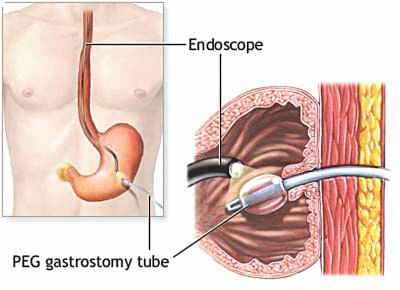Effective alternative feeding

Percutaneous Endoscopic Gastro-stomy (PEG) is a procedure to provide food, liquids and medications directly into the stomach in patients who cannot take food by mouth. It is a 15-20 minute procedure for placing a feeding tube directly into the stomach through a small cut in the tummy skin.
Many stroke patients, for example, those who have poor swallowing, unable to safely consume enough food or those having muscle weakness that allows food to leak into the lungs when they swallow things by mouth. Many of these patients will benefit from a PEG tube in order to receive adequate nutrition and to prevent them from respiratory problems that develop when food or fluids accidentally get into the lungs.
It can be safely and effectively done both in children and adult. Surgeons place the tube with the aid of an endoscope, an instrument to see inside patient’s stomach and intestines. Patient is kept under sedation to keep them comfortable.
Ryles tube or Nasogastric (NG) feeding tubes are an alternative to PEG tube. It is passed through the nose into the stomach for feeding. Long-term use of these tubes can cause irritation, infection or bleeding of the nose and throat. These tubes also have a tendency to be accidentally pulled out.
The PEG tube should be flushed with water before and after feedings, or after medications have been administered in order to prevent clogging. It is imperative that the caregiver or patient thoroughly washes their hands with soap and water before preparing formula or having contact with the PEG system.
Most medications that come in tablet or pill form can be crushed and dissolved in water and passed through the feeding tube.
The lifespan of the PEG feeding tube is about 1 year although the tube may wear out sooner. When the tubing begins to wear, you will notice pits, bumps and leaks on the side of the tube. In addition, the feeding tube cap may split or fail to close properly. You should notify your physician if this develops.

 For all latest news, follow The Daily Star's Google News channel.
For all latest news, follow The Daily Star's Google News channel. 



Comments